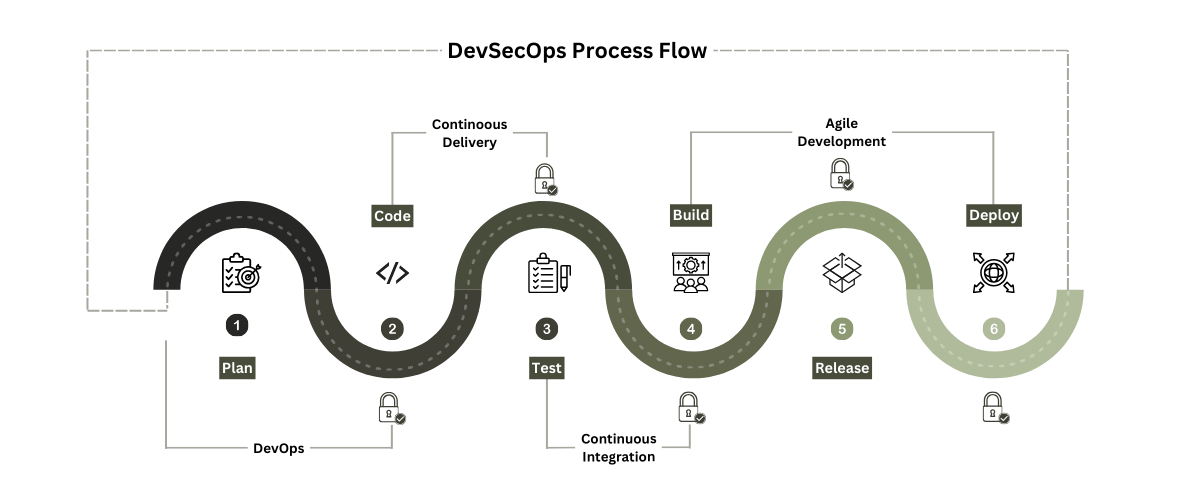Ever wondered how some businesses are able to attract more clients and achieve unparalleled success in this technology-driven world? What if there was a way to streamline your secure software development lifecycle (SDLC), enhance security measures, and ultimately take your business to new heights? By understanding what is DevSecOps methodology, many of these questions will answer themselves!
Yes! Look no further than DevSecOps! DevSecOps, a fusion of Development, Security, and Operations, represents a paradigm shift in secure software development. It underscores the necessity of integrating security seamlessly into every phase of the DevSecOps lifecycle. By doing so, DevSecOps aims to enhance the overall security posture while maintaining the agility and efficiency of modern development processes.
What is DevSecOps Methodology?
At its core, what is DevSecOps methodology? The DevSecOps methodology revolves around breaking down silos between development, security, and operations teams. It emphasizes collaborative efforts throughout the software development lifecycle (SDLC), ensuring security is not an afterthought but an integral part of the entire process. This approach fosters a proactive stance against potential threats and bolsters vulnerability management, ensuring teams can identify and mitigate risks swiftly.
What Does DevSecOps Stand For?
As we explore what is DevSecOps methodology, it’s essential to understand its acronym. DevSecOps stands for Development, Security, and Operations. This methodology integrates security practices directly into the DevOps pipeline, leveraging DevSecOps tools such as CI/CD security measures. Traditionally, security has been a separate phase that occurs after development and before deployment, often leading to delays and vulnerabilities. DevSecOps shifts this paradigm by embedding security throughout the DevSecOps lifecycle, ensuring that security is a shared responsibility from the beginning. This also extends to cloud security, ensuring that cloud infrastructures are protected throughout the entire development and operations process.
In DevSecOps methodology, each aspect—development, security, and operations—plays a crucial role:
- Development focuses on writing code and creating new features. In a DevSecOps environment, developers are encouraged to write secure code from the outset, incorporating security principles into their everyday work.
- Security involves implementing measures to protect applications and data from threats. In DevSecOps, security is no longer an isolated function; it is integrated into the development process. This includes practices such as automated security testing, continuous monitoring, and threat modeling.
- Operations ensures that applications run smoothly and efficiently once deployed. In DevSecOps, operations teams work closely with development and security teams to deploy applications in a secure and reliable manner, leveraging automation and continuous feedback loops.
By understanding what DevSecOps methodology is, organizations can create a culture of shared responsibility where security is everyone’s concern. This integrated approach helps to identify and mitigate vulnerabilities early in the development process, leading to more secure and resilient applications.
Why is DevSecOps Important?
In a world where cyber threats loom at every corner, ensuring security in agile development has become paramount. DevSecOps security is not just a buzzword; it has become a mould-breaking approach in this digital generation. By blending security practices with development and operations, DevSecOps integration creates a culture of collaboration and shared responsibility. 77% of security teams now use automated tools to scan code for vulnerabilities, highlighting the critical role DevSecOps plays in modern development. The earlier security is incorporated, the faster vulnerabilities can be remediated—organizations using DevSecOps practices report a 48% increase in vulnerability remediation speed.
One of the essential pillars of DevSecOps culture is fostering a mindset where everyone on the team—whether they are developers, operations staff, or security personnel—takes ownership of security. This cultural shift is vital for overcoming the challenges in DevSecOps implementation, such as balancing speed with security, effectively integrating tools, and maintaining security without disrupting workflows.
Key Reasons Why DevSecOps is Important
- Enhanced Security Posture: Security is embedded into the DevSecOps lifecycle, identifying vulnerabilities early through automated security testing and application security tools.
- Faster Time-to-Market: Leveraging DevSecOps automation, businesses can speed up the deployment of secure applications.
- Improved Quality: Continuous security testing and feedback loops ensure a higher standard of code.
- Cost Efficiency: Early detection of security issues reduces the cost of fixes in production.
- Continuous Improvement: Continuous Integration/Continuous Deployment (CI/CD) processes improve over time as security testing becomes more efficient.
- Increased Collaboration: DevSecOps encourages teams to work together, sharing responsibility for security from the outset.

DevSecOps Process Flow
In today’s digital world, cyber threats are everywhere, making security in the development lifecycle crucial. DevSecOps builds security into your software from the start. It fosters collaboration among developers, security teams, and operations to identify and manage risks effectively through security by design. It also includes a robust framework for vulnerability management, identifying potential threats at every stage.
Functions of DevSecOps: What Does DevSecOps Do?
Now, let us closely examine what does DevSecOps do. DevSecOps functions as the guardian of software integrity, performing continuous threat modeling, vulnerability scanning, and automated security testing. This methodology enables CI/CD security, ensuring that security is considered at every iteration of development, minimizing the chances of security gaps.

What are the Benefits of DevSecOps?
The benefits of DevSecOps are numerous and transformative:
- Enhanced Security: Security is integrated into every stage of the DevSecOps pipeline through tools like SAST and DAST, reducing the risk of data breaches.
- Faster Time-to-Market: With DevSecOps automation, software development becomes more agile, allowing faster deployment of secure applications.
- Improved Quality: Continuous testing ensures software is more resilient against threats.
- Increased Collaboration: DevSecOps tools encourage teams to work closely, improving overall project efficiency.
- Compliance and Governance: By aligning with security standards and regulations, DevSecOps enhances the company’s ability to meet compliance and governance requirements.
- Compliance and Governance: By aligning with security standards and regulations, DevSecOps enhances the company’s ability to meet compliance and governance requirements.
How Does DevSecOps Work?
DevSecOps operates by embedding security practices into every phase of the software development lifecycle (SDLC). Instead of treating security as a final checkpoint, DevSecOps integration emphasizes the need for security from the beginning of development all the way through deployment and monitoring. Here’s how DevSecOps functions to streamline and secure the process:
- Security Automation in CI/CD Pipeline
One of the fundamental components of DevSecOps is the integration of security into the CI/CD pipeline. Continuous Integration (CI) and Continuous Delivery (CD) ensure that every change to the code is tested and validated quickly. DevSecOps automation uses automated security tools like Static Application Security Testing (SAST) and Dynamic Application Security Testing (DAST) to continuously scan for vulnerabilities during the development process.
By automating security processes, DevSecOps tools can quickly detect potential threats and weaknesses, allowing developers to fix them immediately. This proactive security model reduces the chances of vulnerabilities making it into production.
- Security by Design
In a traditional DevOps environment, security often comes after development, leading to delays and last-minute fixes. However, with DevSecOps, the philosophy is to incorporate security by design. Security is not just a phase; it is embedded into every step of the process, from the initial design to the final deployment.For example, during the planning stage, threat modeling and risk assessment are performed. In the coding stage, developers follow secure coding practices and conduct security reviews. During testing, security tools like SAST and DAST run automated tests to identify vulnerabilities. - Collaborative Culture Between Development, Security, and Operations
The success of DevSecOps relies heavily on fostering a DevSecOps culture of collaboration among the development, security, and operations teams. All teams share responsibility for security, ensuring that potential risks are identified and addressed earlier. This prevents the bottleneck where security reviews and fixes traditionally cause delays at the end of the development cycle.The shift-left approach, where security is incorporated early in the DevSecOps lifecycle, ensures that security is everyone’s responsibility, fostering a sense of ownership across teams. - Continuous Monitoring and Feedback Loops
Continuous monitoring is another essential feature of DevSecOps. Once an application is deployed, security doesn’t stop. DevSecOps tools enable continuous monitoring of applications in production environments to detect real-time threats or vulnerabilities. If any vulnerabilities or threats are identified, the system automatically triggers alerts, allowing teams to address them promptly.This continuous feedback loop ensures constant communication between the teams. As vulnerabilities or issues are discovered, they are shared with the development team, enabling fast iteration and mitigation. This also helps in maintaining compliance and governance by adhering to industry regulations and security standards. - Infrastructure as Code (IaC)
In DevSecOps, Infrastructure as Code (IaC) plays a vital role in ensuring that the entire infrastructure is managed through code, which can be version-controlled, tested, and deployed automatically. This ensures that security configurations, such as firewalls, network permissions, and authentication mechanisms, are applied consistently across all environments.IaC also helps maintain cloud security by allowing cloud infrastructure to be provisioned and managed using the same DevSecOps principles, reducing the risks associated with manual misconfigurations. - DevSecOps Metrics and KPIs
DevSecOps metrics and KPIs are used to track the efficiency and security of the development process. Key performance indicators (KPIs) could include the number of vulnerabilities detected early, time to remediate security issues, and frequency of security testing. These metrics provide actionable insights that help in refining the DevSecOps process and improving overall security.
Common KPIs include:
-
- Vulnerability Detection Rates: How many vulnerabilities are identified in early stages vs later stages?
- Mean Time to Repair (MTTR): How quickly are security issues resolved after being identified?
- Deployment Frequency: How often are secure deployments made, ensuring no delays from security issues?
-
- Cloud Security Integration
Cloud-native applications are becoming the norm, and DevSecOps ensures cloud security by integrating security practices within cloud environments. Cloud infrastructure is treated like any other code in the DevSecOps pipeline, ensuring secure configurations and automated vulnerability assessments. This is especially important in modern development environments where cloud services like AWS, Azure, and GCP are commonly used.Security automation tools such as Container Security Scanners (for Docker, Kubernetes) and Cloud Security Posture Management (CSPM) tools work alongside DevSecOps to ensure that all cloud resources are secure and compliant.
DevSecOps vs. DevOps
While DevOps focuses on collaboration between development and operations, DevSecOps adds an essential layer of security. It ensures that security is integrated into every aspect of the DevOps pipeline through the use of common DevSecOps tools like Jenkins, GitLab, and Ansible. It also emphasizes compliance and governance, ensuring that security measures align with industry standards.
Challenges of Succeeding at DevSecOps
Despite the benefits, implementing DevSecOps presents challenges like balancing speed and security , ensuring effective vulnerability management, and integrating DevSecOps tools into existing systems. Overcoming these challenges requires a strategic approach, including clear communication, effective tool integration, and continuous improvement in DevSecOps culture
Best Practices for Succeeding at DevSecOps
- Automate Security Processes: Use DevSecOps automation tools to integrate security checks into your CI/CD pipeline.
- Shift Left Security: Conduct security assessments early in the development process.
- Use Infrastructure as Code (IaC): Manage and provision infrastructure through code, reducing misconfigurations and improving security.
- Track DevSecOps Metrics and KPIs: Monitor key performance indicators related to security, deployment speed, and quality to measure the success of your DevSecOps initiatives.
Key Components of DevSecOps
The key components of DevSecOps include collaboration, automation, continuous monitoring, and feedback loops, all working together to enhance security in the DevSecOps lifecycle. Tracking DevSecOps metrics and KPIs ensures that performance is consistently measured, helping teams optimize their security practices over time.

Common DevSecOps Tools
Some of the most popular DevSecOps tools include:
- SAST and DAST for security testing
- CI/CD tools like Jenkins and GitLab
- Monitoring tools like Prometheus and Grafana
- Configuration management tools like Ansible and Puppet
Final Note
In conclusion, DevSecOps stands as a cornerstone in modern software development, reshaping how organizations approach security. By integrating common DevSecOps tools, fostering security by design, and leveraging DevSecOps automation, your organization can stay ahead of cyber threats while maintaining agility. Additionally, compliance and governance, effective vulnerability management, and tracking DevSecOps metrics and KPIs ensure that your business remains secure and competitive.






 What is XBRL: Learn the Definition, its Benefits, and Trends
What is XBRL: Learn the Definition, its Benefits, and Trends  Agentic AI vs Generative AI: What’s the Difference and Why It Matters
Agentic AI vs Generative AI: What’s the Difference and Why It Matters  The Hidden Costs of Incorrect EDGAR Filing and XBRL Tagging – And How to Avoid Them
The Hidden Costs of Incorrect EDGAR Filing and XBRL Tagging – And How to Avoid Them  What is Agentic AI and How It’s Transforming Business Operations
What is Agentic AI and How It’s Transforming Business Operations  AI Tools For Small Businesses
AI Tools For Small Businesses 